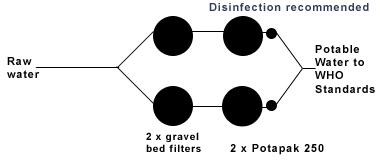Installation Information
A well drained site is recommended for all tanks to prevent damage to the system by settlement. A concrete base may also be used. The components of the system itself are easily transported by pick-up or small trailer and simple to install.
The specification requirements for sand and for the filtration sand bed are very broad. In most cases this allows the sand to be sourced locally.


Typical Installations
 |
 Hover over image sections for information |
| Solar-powered Installations | |
 The system has been designed to be low maintenance. The top fabric filter requires rinsing once every two weeks and backflushing every three months. The System is safe against misuse and the most likely result of misuse would be a failure of water flow, rather than the introduction of pathogenic organisms. Potapaks come with full instructions.
The system has been designed to be low maintenance. The top fabric filter requires rinsing once every two weeks and backflushing every three months. The System is safe against misuse and the most likely result of misuse would be a failure of water flow, rather than the introduction of pathogenic organisms. Potapaks come with full instructions.

|
 |
||||
|
 |
||||
|
 |
||||
|
 |
||||
The table above gives a guide to the ways in which the Potopak kits may be combined to deal with a range of raw water qualities.
BACK TO THE TOP